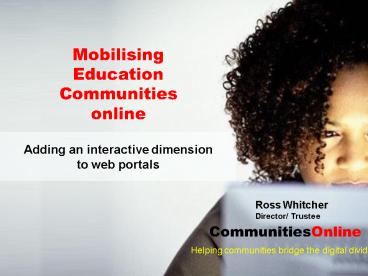Adding an interactive dimension to web portals - PowerPoint PPT Presentation
1 / 16
Title:
Adding an interactive dimension to web portals
Description:
Asia Pacific Network for Education to share knowledge and make new knowledge for ... DIY - self managing communities. ICT at its best - learning by doing - in ... – PowerPoint PPT presentation
Number of Views:56
Avg rating:3.0/5.0
Title: Adding an interactive dimension to web portals
1
Adding an interactive dimension to web portals
Mobilising Education Communities online
Ross Whitcher Director/ Trustee
CommunitiesOnline
Helping communities bridge the digital divide
2
Communities Online? Not for profit international
trust - (foundation) Interactive web communities
for education, life long education, community and
economic development. Involved with learning
and community development groups in 9 countries
and 19 languages - (Asia, Australia, New Zealand,
Southern Africa.) Consortium for APEC Cyber
Education Cooperation (with USA Dept of
Education, Korean Ministry of Education, Hong
Kong University) Asia Pacific Network for
Education to share knowledge and make new
knowledge for Pacific Rim countries in
conjunction with ministries of education of 5
other countries Helping government, districts,
schools develop web policies and implement
online communities
ICT Learning by Doing Involved in the learning
process from bottom up. Empowerment of
individuals and grass roots groups.
CommunitiesOnline
3
What is the future? People see rules increasingly
being made for them but they want to live
increasingly by their own values. Top-down
communications best left to the media and The
President. Rest of us want to be able to interact
with others on our terms. We need to be able to
save time, energy and stress. We need to be able
to do things ourselves. This is just one story -
ours.
The Future?
F AST U RBAN T RIBAL U NIVERSAL R EACTIONARY E
THICAL (Dr Patrick Dixon, UK)
CommunitiesOnline
4
Teachers and students tell us
X
- they want to be able to interact better with
- other teachers and students
- administrators
- parents and care givers
- other school stake holders
- their whole community( sometimes worldwide)
Yesterdays Communication model - a static web
page
Wherever and whenever the wish
Todays Interaction model -an Interactive Web
Community
Oops - just dreaming, or am I ?.)
5
Interactive Web Community structure
A community of web groups Enabing individuals and
groups to participate online, with little
training.
- For users
- Own online presenceA do-it-yourself web site (a
mini portal of dynamic content) - Participants create their own web presence and
choose functions to suit special needs - publish web-pages
- advertise events
- issue news items
- publish articles
- run discussion forums
- make announcements
- bulk email members of web groups
- Access from any web browser
- No specialist skills required.
- No special tools.
- No software needed
- All content automatically indexed and searchable
within community site.
Whole of community structure Unlimited
number of e -groups - linked and indexed.
E- Groups Each a mini-portal
CommunitiesOnline model
6
School community online
Interactive Web Community - The big picture
Fully indexed managed
Cmonline model
Other local web sites, eGroups, and online
presences
All community can participateas individuals or
groups.
7
Teachers, students, administrators
Whole of community
Parents, caregivers
School Boards, Part time specialists, sports
coaches, parent teacher organisations
The whole community can benefit from belonging to
a school network.
Community Organisations (eg City Library, Alumni,
Businesses, those with an interest in the school.)
VALUE NET ( After Brandenberger)
8
Interactive Web communities allow people to
Communicate - one-to-one, one-to-many, in groups,
in public or private Connect - find people, make
connections, build networks, form groups Share
knowledge - find information, create local
knowledge, spread news, share info,
seek help Collaborate - work together, discuss,
survey, feed back Manage - delegate,
facilitate, regulate, monitor, report Inform
- publicise, notify, remind Mobilise - start,
lead, grow, and activate
your group or entire community Educate - teach,
learn (individually or in groups)
grass roots level
9
Teachers, students,administrators manage our own
knowledge and communications, anywhere, anytime
Web-based - everything provided online, no
special technology needed Do-it-yourself -
user-driven, easily create your own eCommunity
online No special skills or knowledge needed Your
own language of choice Any language, (can
easily add other minority languages) Use any web
browser - runs on slow-speed lines and on
older computers. (Broadband is
obviously faster.) Flexible configurable,
extendable, self-managing Research-enabled
allowing full logging and reporting of community
interactions. Community-funded -free to
subscribers.
Bridging the Knowledge Divide
10
What does it mean for school communities?
- DIY - self managing communities
- ICT at its best - learning by doing - in and out
of school - Teachers,students and whole school community able
to access information and others anywhere,
anytime. - Course students from a wide area - classroom
without walls - Operate in multiple languages ( good for ESOL
learning) - Share knowledge resources, social capital between
schools, districts,countries.
11
What do interactive communities look like?
New Zealand Youth Group - 11-20 yrs
12
E-group activity
Jemma Hartley - 11 yrs
13
Motivational Challenges
Community Administrator 18yrs
14
Arabic Bahasa IndonesiaBahasa
MalaysiaBengali Chinese Traditional Chinese -
Simplified Cook Islands Maori Dutch English Fr
ench German Hindi Italian Japanese Korean Ma
ori Niuean Portuguese Russian Samoan Spanish
Tagálog Thai Tokelauan Tongan UrduVietnamese
Multi cultural multi lingual
15
Interactive Web Communities
- Support physical learning
- communities, their
- structures,
- relationships,
- interactions, and
- languages
16
Project Evaluation of e-Education Online
Communities
measure programme impact, outcomes and
performance draw some lessons on the issues of
sustainability and replicability use analysis of
empirical ( Facts), evaluative ( values) and
normative (action) participatory approach to fit
the promise of democratisation, participation and
empowerment - appropriate here for an online
community project emphasises the importance of
cultural identity of local communities, and of
democratisation and participation at all levels
individual, local, regional and national































